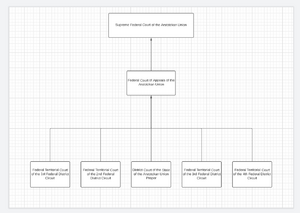Federal judiciary of the Arstotzkan Union

The Federal Judiciary of the Arstotzkan Union is responsible for the system of courts that interprets and applies the laws of the Arstotzkan Union. It has four primary functions: to provide a mechanism for dispute resolution; to deliver authoritative rulings on the meaning and application of legislation; to develop case law; and to uphold the rule of law, personal liberty and human rights. The judiciary is supported in its work by an executive department, the Ministry of Justice.
The court system has four levels: the Supreme Federal Court is the highest court; the Federal Court of Appeal hears appeals from the Federal Executive Court on points of law; the Federal Executive Court deals with serious criminal offences and civil matters, and hears appeals from the lower courts; and the Federal Territorial Courts. There is also the Federal Judicial Council which holds members from each court to discuss and aid the Executive Committee and First President on appointment of federal judges.

Court hierarchy
The Supreme Federal Court sits at the apex of the Arstotzkan Union's court hierarchy as the final appellate court. Cases may only go to the Supreme Federal Court if it grants "leave to appeal". It generally hears appeals of considerable public interest, commercial significance, substantial miscarriages of justice or significant issues relating to the Constitution of the Arstotzkan Union. The chief justice presides over the Supreme Court. Before the Supreme Court first met in 2020, the Arstotzkan National Court served as the highest court.
The Federal Executive Court and Federal Court of Appeal are subordinate appellate courts. The Federal Executive Court is also the highest court of first instance, primarily hearing complex cases or those cases which exceed the lower courts' jurisdiction. This includes all criminal trials for murder, manslaughter and treason. The District Court hears more than 95% of all criminal trials.
Law
Main article: Arstotzkan Law
The Arstotzkan Union practices the common law legal system, where the decisions of higher courts constitute binding precedent upon courts of equal or lower status within their jurisdiction, as opposed to the civil law legal system in the continental Europe.
The laws of the Arstotzkan Union are based on the Constitution, and decisions of the Arstotzkan courts. The laws are based on three related principles: federal authority, the rule of law, and the separation of powers. In interpreting common law, Federal judges have followed the practice of the doctrine of precedence in order to aid in the cementing of common law in the Arstotzkan legal system.
Judges
The Chief Justice is formally appointed by the First President on the recommendation of the Federal Judicial Council and Executive Committee. All other federal judges are appointed by the Federal Judicial Council on the advice of the attorney-general, and the chief justice.
Judges and judicial officers are appointed non-politically and under strict rules regarding tenure to help maintain judicial independence from the executive government. Judges are appointed according to their qualifications, personal qualities, and relevant experience. The Arstotzkan Union does not have an official judicial appointments commission as in many other democracies, rather it has temporary commissions established by the Federal Judicial Council to report to the Executive Committee for appointments. As for removal from the bench, judges have only rarely been removed from the bench in the Arstotzkan Union. A judge may not be removed from office except by the attorney-general upon an address of the Executive Committee for proved misbehaviour.
Judges of the Supreme Federal Court, Federal Court of Appeal and Federal Executive Court are titled "Justice", while those of lower courts are titled "Judge". The title "Justice" is abbreviated, however "Judge" is not. For example, a judge of the Federal Executive Court would be referred to as Gedye J, whereas a judge of the Federal Territorial Court would be referred to as Judge Brinkman. Judges in the Arstotzkan Union are addressed as "Your Honour" or "Sir/Madam"; in court settings, or they may be addressed simply as "Judge". Outside of this they are expected to be referred to as Comrade.
Unlike in New Zealand, Federal judges in the Arstotzkan Union do use gavels.
History
The Court system in the Arstotzkan Union was established on 22 August 2019 with the establishment of the rest of the nation. However the courts only consisted of one court, the Arstotzkan National Court. During the federalisation of the Arstotzkan Union, on 26 November 2020 the Supreme Federal Court of the Arstotzkan Union was established. With Ethan Brinkman appointed as the chief justice. However as he was the only member at the time, Ethan used his power to grant his government judicial authorization to begin a war with the Confederate Democracy of Gamers. On 30 November 2020, Peter Gedye was appointed as Attorney-General of the Arstotzkan Union and he became the second member of the judiciary.
On 31 August 2021, the Arstotzkan Federal Government passed the Arstotzkan Statute on Government Systems (2021) and it properly created the separation of powers in the Arstotzkan Union. It also, with later amendments, created the judiciary and eventually the Federal Judiciary was created on 19 October 2022.
Following the passing the Arstotzkan Statute on Government Systems, the Supreme Federal Court was joined by the Executive Supreme Court, which was created on 23 November 2021, but was replaced by the Federal Court of Appeals on 19 October 2022. All other courts were made on this day.